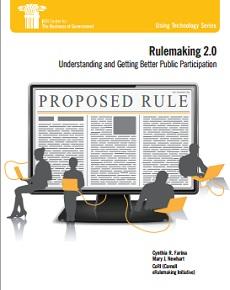
New Report Examines the State of Rulemaking 2.0

The IBM Center for The Business of Government is today releasing a new report, Rulemaking 2.0: Understanding and Getting Better Public Participation, by Cynthia R.Farina and Mary J.Newhart with CeRI (the Cornell eRulemaking Initiative).
This report provides important insights in how governments can improve the rulemaking process by taking full advantage of Rulemaking 2.0 technology, building on the progress made by the U.S. Government’s longstanding Regulations.Gov initiative. The report’s findings and recommendations are based on five experiments with Rulemaking 2.0 conducted by CeRI researchers, four in partnership with the Department of Transportation and one with the Consumer Financial Protection Bureau.
While geared specifically to achieving better public participation in rulemaking, the concepts, findings, and recommendations contained in the report are applicable to all government agencies interested in enhancing public participation in a variety of processes. The report offers advice on how government organizations can increase both the quantity and quality of public participation from specific groups of citizens, including missing stakeholders, unaffiliated experts, and the general public.
The report describes three barriers to effective participation in rulemaking: lack of awareness, low participation literacy, and information overload. While the report focuses on rulemaking, these barriers also hinder public participation in other arenas. The report offers three strategies to overcome such barriers:
- Outreach to alert and engage potential new participants
- Converting newcomers into effective commenters
- Making substantive rulemaking information accessible
This report makes an excellent companion piece to two previous IBM Center reports. In 2011, the Center published Assessing Public Participation in an Open Government Era: A Review of Federal Agency Plans, by Carolyn Lukensmeyer, Joe Goldman, and David Stern. That report addresses how public participation can be increased via online public participation, face-to-face public participation, and formal public participation (such as rulemaking and federal advisory committees). An earlier IBM Center report, The Management of Regulation Development: Out of the Shadows, by American University President Cornelius Kerwin, addressed the need to government to give increased attention to its role in regulation development and rulemaking.
We hope that this report will be informative and useful to public managers seeking to enhance public participation in their organization, including increasing participation in the all important rulemaking process.



